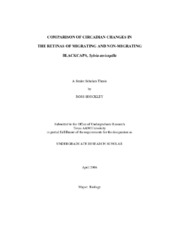| dc.description.abstract | The retinas of birds and other vertebrates undergo morphological and physiological
changes throughout the day, which help regulate daily changes in visual sensitivity. One
particular change is the contraction and elongation of photoreceptor outer segments,
which is regulated by an endogenous circadian clock. Normally, Blackcaps (Sylvia
atricapilla) are diurnal, but they migrate at night. In the current experiment, outer
segment lengths of migrating and non-migrating Blackcaps were measured throughout
the day and analyzed, and they show a trend toward circadian rhythmicity across the
day. There also appears to be an advance in the phase of the rhythm in retinomotor
movements when birds are migrating. These results indicate that circadian-controlled
retinomotor movements could be modifications within the retina to accommodate the
nocturnal lifestyle of migratory Blackcaps. We hypothesize that a change in retinal physiology and morphology may allow the formation of a migratory “night-vision” to
accommodate the migrating Blackcap’s nocturnal lifestyle. | en |


